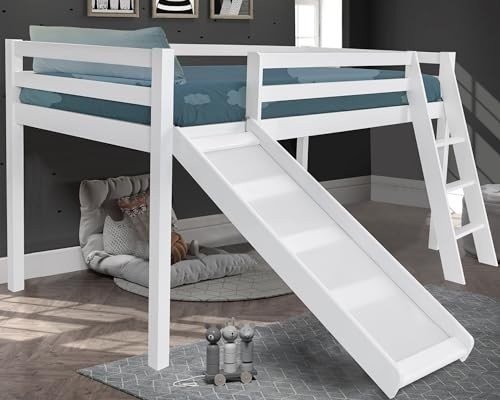A Comprehensive Guide to Children's Bunk Beds: Styles, Benefits, and Safety Considerations
Bunk beds have actually ended up being a popular choice for families looking to optimize space and provide an enjoyable sleeping environment for kids. With their distinct style, they use a creative and useful solution for shared bed rooms, playrooms, or perhaps guest accommodation. This short article explores the different designs of kids's bunk beds, their benefits, safety considerations, and addresses some regularly asked questions.
The Allure of Bunk Beds
Children's bunk beds are more than just space-saving structures; they are also a gateway to adventurous dreams and creative play. Below is a detailed evaluation of their many benefits.
Benefits of Bunk Beds
- Space-Saving: Bunk beds effectively make use of vertical space, making them an ideal option for smaller sized rooms.
- Lively Design: Many bunk bed styles include slides, tents, and themed components, triggering creativity and excitement.
- Partner Sharing: Bunk beds are perfect for brother or sisters sharing a space or accommodating sleepovers.
- Flexible Use: Some models can be separated into 2 individual beds, using versatility as children grow.
- Storage Options: Many bunk beds include built-in drawer storage or shelves, even more improving their practicality.
Styles of Children's Bunk Beds
The range of bunk beds readily available today caters to various preferences and needs. Below is a summary of some popular styles.
| Style | Description | Best For |
|---|---|---|
| Requirement Bunk Bed | A standard design featuring one bed stacked above another. | Siblings sharing a room. |
| Loft Bed | Comparable to a bunk bed without the bottom bunk, enables a work space or play location listed below. | Minimal space for play/desk. |
| L-Shaped Bunk Bed | Two beds set up in an L-shape, often with extra sections for storage or play. | Distinct space layouts. |
| Twin Over Full | A twin bed over a complete bed, accommodating various sleep requirements. | Growing kids and teens. |
| High Sleeper | Stands even higher than a loft bed, generally featuring a desk or play area below. | Older kids needing more play/desk space. |
| Tent Bunk Bed | Bunk beds with a canopy or tent-like structure, developing a cozy, enjoyable space. | Active and imaginative children. |
Key Features to Consider
When picking the right bunk bed for kids, the following features are worth considering:
- Material: Bunk beds can be made from wood, metal, or a mix. Each has its distinct aesthetic and sturdiness.
- Weight Capacity: Always verify the weight limit of the bunk bed to ensure it can accommodate your children securely.
- Security Rails: Ensure the top bunk has sturdy rails to avoid falls.
- Ladder Security: A properly designed ladder must provide simple and safe access to the upper bunk.
- Ending up: Ensure any surfaces are non-toxic and safe for children.
Safety Considerations
Security is critical when it comes to kids's bunk beds. The following guidelines should be adhered to:
- Age Appropriateness: Generally, children under 6 years of ages ought to not sleep in the upper bunk due to security risks.
- Strong Construction: Ensure the frame and materials are strong and can support the weight without sagging.
- Regular Maintenance: Periodically look for loose screws, bolts, or other elements that might need tightening.
- Clear Play Area: Keep the location around the bunk bed free of toys and barriers to minimize tripping threats.
Setting Rules for Safe Use
Developing standards for bunk bed use will help make sure safety:
- Limit Jumping and Climbing: Children must be encouraged versus jumping from the leading bunk and climbing up on the sides.
- Monitoring Sleepovers: Monitor young guests while they are using the bunk bed for the very first time.
- Inform on Ladder Use: Teach how to use the ladder safely, stressing the significance of facing the ladder when climbing or down.
Frequently Asked Questions
1. What age is suitable for a child to sleep in the leading bunk?
Most makers advise that children need to be at least six years of ages to sleep in the upper bunk. This guideline is developed to alleviate the danger of falls.
2. Can bunk beds be customized?
Yes, lots of manufacturers provide customizable choices, including colors, materials, and additional features like drawers or desks.
3. Are bunk beds safe for weight?
Bunk beds have weight limits, normally ranging from 200 to 400 pounds, depending upon the model and material. Always check the producer's specifications.
4. How do I preserve and clean a bunk bed?
Regularly look for loose parts, keep the bed clean by cleaning down surfaces, and make sure the bed linen is fresh to promote a safe and sanitary sleep environment.
5. Can bunk beds be separated into specific beds?
Lots of bunk beds come with an option to separate them into two private beds, offering long-lasting flexibility.
Children's bunk beds are more than simple furniture; they are a functional, flexible, and creative component of a kid's space. With numerous designs offered and various security considerations to bear in mind, moms and dads can select the perfect bed that fits their space, satisfies their children's requirements, and instills a sense of experience. By comprehending the advantages, styles, and precaution related to bunk beds, households can create a wonderful and secure sleeping environment for their kids. Whether for special info sharing a space or space-saving solutions, bunk beds stay a cherished option for numerous households.

